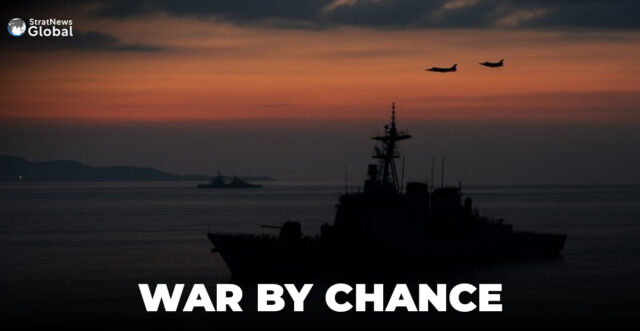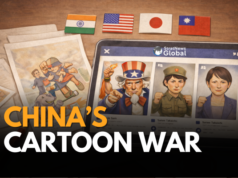Tensions across the Taiwan Strait are once again raising fears that Beijing and Taipei could stumble into conflict. While much of the debate focuses on a deliberate war of choice by China or a war of necessity triggered by Taiwan’s declaration of independence, experts warn of a third, more unpredictable path: a war of chance.
In an article published in Foreign Affairs, Joel Wuthnow, a Senior Research Fellow at the Institute for National Strategic Studies at the U.S. National Defense University, argues that an accidental conflict sparked by miscalculation is the most likely danger confronting China, Taiwan, and the United States. Wuthnow, co-author of China’s Quest for Military Supremacy, stresses that although wars of choice or necessity can be deterred through policy, the risk of a war of chance remains inherent and far harder to eliminate.
Unlike a calculated invasion or a redline-driven confrontation, a war of chance could erupt suddenly. Wuthnow describes a plausible scenario: a Chinese fighter jet flying too close to Taiwan ignores repeated warnings and is shot down. Beijing retaliates against Taiwan’s air defences, leading to casualties. The United States, uncertain of Beijing’s intent, mobilises forces in the region. China responds in kind. With each side interpreting the other’s actions as aggression, escalation could quickly spiral beyond control.
History is full of such examples. The assassination of Archduke Franz Ferdinand in 1914, which ignited World War I, is cited by Wuthnow as a textbook case of how accidents can cascade into global conflict. Similarly, the American Revolution began when a British soldier fired the “shot heard ’round the world” in Concord, Massachusetts—an act against orders that nonetheless sparked war. Other cases include the Peloponnesian War, which grew from a local dispute, and the Second Opium War, triggered in 1856 by the arrest of a ship’s crew in Canton.
Three factors, Wuthnow explains, make such accidents especially dangerous: frequent contact between rival militaries, political pressures that make backing down costly, and the mobilisation of allies that magnify small disputes into major confrontations. All three, he warns, are present in the Taiwan Strait today.
Chinese military activity around Taiwan has sharply increased. In January 2025, Chinese jets crossed the Strait’s centerline 248 times, more than triple the number from the same month a year earlier. In April, a Chinese fighter approached within 40 miles of Taipei, and Chinese navy ships entered Taiwan’s contiguous zone for the first time during the “Strait Thunder” exercise. The Chinese Coast Guard has also taken provocative actions, such as detaining the crew of a Taiwan-flagged vessel near Kinmen in 2024. These manoeuvres, Wuthnow notes, carry exactly the kind of risks that could spark a war of chance.
Political dynamics further complicate de-escalation. Beijing, having long portrayed Taiwan as a breakaway province, cannot afford to appear weak, especially if the United States or its allies intervene. Taiwan’s leaders, meanwhile, must contend with strong public sentiment for autonomy. Roughly a quarter of Taiwanese favour independence now or in the future, making concessions politically costly. Protests or nationalist outrage on either side could lock leaders into escalation.
The possibility of U.S. involvement adds another layer of danger. Washington could misinterpret an accident as the prelude to an invasion and respond with force. Domestic political pressure might push the White House toward intervention, while Beijing, fearing a U.S. attack, could launch preemptive strikes.
Reckless actions by individual Chinese pilots or sailors are another concern. Wuthnow recalls the 2001 collision between a Chinese J-8 fighter and a U.S. reconnaissance plane, which led to the death of the Chinese pilot and the detention of the American crew. More recent incidents include a near-collision between a Chinese J-11 and a U.S. B-52 in 2023, clashes with Philippine forces in the South China Sea, and even a collision between two Chinese vessels in pursuit of a Philippine ship. None of these sparked war, but in the volatile Taiwan Strait, similar accidents could prove catastrophic.
To reduce risks, Wuthnow calls for greater restraint and communication. The PLA should avoid provocative manoeuvres close to Taiwan’s air and sea boundaries. Taiwan’s military, in turn, should act cautiously in enforcing its defences. Leaders on both sides must also rein in rogue operators and establish mechanisms to flag dangerous incidents.
Dialogue, even indirect, is essential. Although Beijing refuses direct talks with Taiwan’s President William Lai, Wuthnow suggests backchannel communication through research institutes or unofficial intermediaries could provide off-ramps during crises. The United States, meanwhile, should maintain its policy of strategic ambiguity toward Taiwan. Shifting to strategic clarity, Wuthnow warns, would force Washington into immediate military action during a crisis, raising the risk of escalation.
Ultimately, prevention can only go so far. The United States and Taiwan must also prepare credible plans for managing accidental incidents. Most wargames today focus on deliberate Chinese aggression, Wuthnow notes, leaving policymakers ill-prepared for a crisis sparked by miscalculation. In the Taiwan Strait, where history, geography, and politics collide, improvisation in such a scenario could prove disastrous.
Wars of chance, Wuthnow concludes, are sudden, unpredictable, and often devastating. Careful statesmanship and prudent crisis management may be the only tools available to prevent an accident from becoming a world-altering conflict.
In a career spanning three decades and counting, Ramananda (Ram to his friends) has been the foreign editor of The Telegraph, Outlook Magazine and the New Indian Express. He helped set up rediff.com’s editorial operations in San Jose and New York, helmed sify.com, and was the founder editor of India.com.
His work has featured in national and international publications like the Al Jazeera Centre for Studies, Global Times and Ashahi Shimbun. But his one constant over all these years, he says, has been the attempt to understand rising India’s place in the world.
He can rustle up a mean salad, his oil-less pepper chicken is to die for, and all it takes is some beer and rhythm and blues to rock his soul.
Talk to him about foreign and strategic affairs, media, South Asia, China, and of course India.





